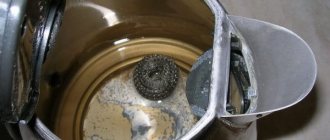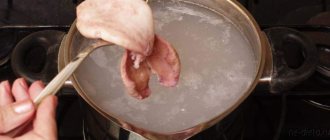Boiler manufacturers
When water is heated, dissolved hardness salts are converted into scale. The intensity of the process increases heating. Harmful deposits clog the working ducts and disrupt normal heat exchange. In thematic materials, manufacturers recommend the use of special protective measures that extend the service life of boilers.
Baxi
Regular removal of calcium deposits is not the best way to combat scale. This procedure is performed using aggressive chemical compounds that destroy the metal and the protective film of oxides. This treatment activates corrosion and damages welded and soldered joints. Preventive measures will help you get a good result without unnecessary risks and costs.
The danger of the formation of calcium deposits is illustrated by an example taking into account the different thermal conductivities of materials. A porous scale layer of 0.15 mm is equivalent to a metal thickness of 5 mm. Such formations provoke overheating of local zones until destruction. At the same time, the increase in coolant temperature slows down and gas consumption increases to maintain the set mode.
Baxi boilers (Made in Italy) are considered one of the best in terms of price-quality ratio
To soften water chemically, soda, lime, and specialized reagents are used. In industrial installations, expensive mixtures are used, which are added to the liquid in precise portions using dosing stations with a pump. In everyday life, polyphosphates are more often used, which bind hardness salts and prevent the formation of sediment. These products can cause an allergic reaction of the skin, therefore they are suitable for treating liquids only in the heating circuit.
To protect against scale, you can use magnetic field treatment or ion exchange. To prevent clogging with mechanical impurities, install a coarse and fine filter.
The following recommendations from the manufacturer will help ensure proper operation of the equipment:
· To clean the boiler, use specialized products based on strong acids with additives that protect the metal;
· the heat exchanger will withstand no more than 3 flushes without damage;
· for the DHW circuit you can use water with a hardness of no more than 4 °F.
In a closed heating system, scale forms only once, so it is permissible to use water with a hardness of up to 7-10 °F. However, if the tightness of the circuit is broken and the expansion tank is in poor functional condition, replenishment is periodically applied. In this case, it is recommended to reduce the concentration of harmful impurities to a minimum or use special anti-scale protection.
Ariston
This manufacturer, in official instructions, reports the need to reduce the level of water hardness, but does not indicate mandatory requirements for this parameter.
Gas boiler Ariston
To reduce the rate of scale formation, the company sets a heating temperature limit (not higher than +65°C).
How to get rid of limescale?
Experts recommend regularly turning on a stream of hot water at full power and leaving it for 20 minutes. This method allows you to remove the top layers of limescale. Additionally, you can clean it yourself using thin, hard copper wire.
To effectively clean the water heater, a washing solution is made from several types of detergents. They are mixed in equal proportions in one liter of boiling water. Then, using a funnel, you need to pour the liquid into the coolant until it flows through the other pipe.
The cleaning agent is left in the heat exchanger for two hours, adding new portions of the cleaning solution through a watering can every 30 minutes.
At the end of the process, you need to connect a shower hose to one of the pipes by disconnecting the funnel. Then turn on a strong flow of clean water to thoroughly flush the system.
In addition to regular cleaning, the use of a water filter helps increase the service life of a gas boiler. In this case, it is necessary to call gas service specialists at least once a year for a complete diagnosis of the equipment. Only they are able to carry out high-quality cleaning, troubleshoot problems and replace the necessary component in a gas boiler.
Why doesn't hot water flow through the column?
1. Clogged filter at the entrance to the water chamber of the block tap. 2. The mixer aerator mesh is clogged with large particles. 3. Scale in the heat exchanger of the gas water heater.
Removing scale and cleaning components is carried out as part of on-site service by professional technicians. If you need help in solving various problems, we are at your service. Leave a request for repair of a geyser via the electronic form and find out the cost of services.
Diagnostics
We diagnose gas flow columns remotely, so the cost of this service for you is
0 Rubles
Call
We will charge 500 rubles for the call if the repair is refused, but this service costs
0 Rubles
Service
The cost of the technical work performed without the cost of the required spare parts varies.
From 900 rubles
Guarantee
Before leaving, our employees will issue a guarantee from our company for the work done for a period of time.
Up to 6 months
How to remove soot from a heat exchanger at home
How to disassemble and assemble with your own hands
Disassembling and cleaning the device is carried out in several successive stages.
Shutting off water and gas
Before removing the heat exchanger, it is necessary to turn off the supply of gas and water. To do this, just close the taps responsible for the gas supply and water supply to the dispenser. Only after turning off the taps can you begin disassembling and cleaning the device.
Draining contents
Sometimes there is some water left in the disconnected column, which must be disposed of in advance. Draining the liquid is carried out as follows:
- closing all shut-off valves;
- opening the hot water tap;
- removing the plug from the special hole for draining the liquid;
- draining water from the system;
- plug installation.
Features of dismantling
It’s easy to remove the heat exchanger yourself, and therefore anyone can handle this job. First, the tubes are removed to allow water to enter and drain. To do this, you will have to unfasten the nuts responsible for fixing the pipes. They need to be treated with WD-40 detergent to get rid of scale. When the pipes are unscrewed, the heat exchanger is removed.
Washing
To clean the part, pour a liquid made from hot water and citric acid inside. It will help get rid of soot and other contaminants. You can also treat the surface with a vinegar solution with hydrochloric acid.
Drying
The washed device must be dried before reinstalling. Before drying, wipe it thoroughly with a dry towel to remove moisture from the surface. Then the heat exchanger is taken out to the balcony if cleaning is carried out in the summer. In winter, it can be dried near a radiator or other heating devices.
Replacing O-rings
To prevent water from leaking through the pipes, you will have to replace the O-rings. Before installing the heat exchanger, you will have to remove the rubber seal installed at the pipe connection and replace it with a new one.
Leak test
The assembled structure must be checked for leaks. To do this, you need to pump some water into the pipes. If it does not leak, it means that the O-rings are installed correctly and the connection is completely sealed.
Operational check
After making sure that the connection is tight, the device is checked during operation. The gas water heater is set on fire to warm up the water. If there are no problems during the heating process, then the device has been assembled and cleaned correctly.
How to descale
With long-term use of columns, not only soot is formed, but also scale, which must be gotten rid of.
Ready-made composition from the store
People who prefer a chemical descaling method often use products from specialized stores. They are highly effective, which allows you to get rid of even old contaminants.
Effective store-bought formulations include:
- Boiler;
- Cleaner E;
- Detex.
With acid
Some people don't want to use chemicals and use acid instead.
Solyanaya
To clean a contaminated surface and protect it from destruction, you can wash it with hydrochloric acid. To remove scale, hydrochloric acid is poured into the heat exchanger and left in it for 15-20 minutes. Then an alkaline solution is poured into it, after which the mixture from the heat exchanger is poured into the sewer.
Orthophosphate
Washing the column with orthophosphate acid is considered effective against scale. In this case, experts recommend using a weakly concentrated solution. To prepare it, you will have to mix acid with water in a ratio of one to five.
Aminosulfonic
To clean a metal surface from scale, you can use aminosulfonic acid
It must be used very carefully, as it reacts with the metal and begins to corrode it. To prevent this from happening, the acid is mixed with inhibitors and water.
Lemon or vinegar
Citric and acetic acid can also be used to remove scale. However, such compositions are less effective, and therefore, in order to clean the metal, it will have to be soaked in liquid for at least four hours.
How to clean soot from a radiator
To clean the radiator from accumulated soot, two main means are used.
Soap solution
Many people use regular soap solutions to remove soot. Before using them, you need to vacuum the radiator to clean it of debris and carbon particles. Then it is washed with soapy water and dried.
A small hook will help to clean the radiator from a large amount of soot. After using it, you need to rinse the part to remove any remaining soot.
Description
DOWNLOAD INSTRUCTIONS
The Geyser 1PFD fill-type filter is designed to protect household appliances from scale and corrosion. The filter housing is made of plastic. High-quality food-grade polyphosphate is used as a filter media.
Please note: water treated with a polyphosphate filter is not allowed for drinking.
Features and Benefits
- Designed to protect heating elements of washing machines, dishwashers, water heaters and boilers from scale and corrosion.
- Used for liquids consumed for technical purposes (you can wash dishes, wash clothes, take a shower).
- Provides gentle washing (laundry becomes softer without the use of special detergents).
- The filter is made of durable plastic and is easily mounted on the cold water supply line.
- The transparent housing allows you to easily monitor the condition of the filter.
- If the backfill consumption is more than ½, it is necessary to replace the filler.
- Reduces the appearance of lime deposits (scale).
- Reduces electricity consumption by household appliances.
- Reduces detergent consumption.
- The average service life of one volume of backfill is 6 months (depending on the hardness salt content and water consumption).
Main characteristics
- Temperature range: up to 40 °C.
- Filtration rate: up to 6 l/min.
- Resource: 6 months. (depends on the parameters of the source water).
- Warranty period: 1 year.
Scale prevention
Regular cleaning of the geyser will extend its service life.
It will allow you to avoid breakdowns within the system, increase its efficiency, and avoid the smell of burning and the appearance of soot in the room. Preventive measures:
- Checking the functionality of the equipment, how the ignition occurs, water temperature, heating rate, etc.
- External inspection of the surface of the structure to identify scale and grease.
- Inspecting the condition of the radiator, checking traction and ignition.
After carrying out preventive work, the degree of contamination of the structure is assessed, and measures are taken to eliminate scale and grease.
To extend the life of the circulation pump, it is recommended to install a mesh on the suction pipe, which will trap dissolved scale, preventing it from entering the radiator.
When cleaning the device, it is important to act carefully, having first studied the instructions for the device and turning off the gas flow. In the event of a gas leak, urgently call 104 to protect the premises from fire
comments powered by HyperComments
Variety of geysers used
The operating principle of speakers from different manufacturers does not differ significantly. Specifications vary.
By what indicators do the models differ:
- Performance;
- Type of burner;
- Degree of security;
- Ignition method;
- Flue gas removal method.
Classification by ignition type:
- Manual. Found on older models. Most modern manufacturers prefer not to use this type of ignition. To turn it on, you need to light the burner yourself with a match.
- Piezo ignition. To turn on the heater, just press a button. Within a few seconds the water from the tap will be hot.
- Electronic ignition. Allows you to save gas, as the automation turns off and turns on its supply.
Based on the type of burners installed, there are two types of heaters. At constant power, manual temperature adjustment is required. With a variable, automatic adjustment occurs. Modulating burners supply water at a uniform temperature.
Speaker power is one of the main selection criteria. Minimum value -16-19 kW. Maximum – 28-32 kW. A heater with low power will heat up to 10 liters of water per minute. This is not enough for a large family. You can only wash the dishes. Average indicators increase the volume to 20.
In order not to encounter the fact that there is no water pressure in the gas water heater, you should choose trusted manufacturers. The German and Italian companies have gained trust in the market. But there are domestic popular brands. The Neva geyser combines proven quality and an affordable price.
How to flush a speaker radiator?
In most cases, scale accumulates in the radiator. Therefore, it is most advisable to start cleaning it first.
It is important to note right away that this can be done in one of two ways. Each of them gives excellent results
Therefore, the choice is yours.
Method No. 1: cleaning with special means
You can remove scale from the geyser that has accumulated in the radiator using special cleaning agents (for example, silit or another that quickly removes scale). In addition to them, to carry out such work you will need the following:
The anti-scale solution should remain in the heat exchanger for several hours.
- garden sprayer;
- two clamps;
- PVC hose;
- bucket;
- cork;
- screwdrivers;
- spanners.
So, the first thing you need to do is turn off the gas.
Then you will need to tighten the tap of the incoming water pipe. Then you need to immediately place a bucket under the entrance from the gas water heater, since water will come out from there. Next, you need to plug the spout of the faucet in the bathroom or kitchen with a stopper and turn on the tap through which cold water flows. At this time, it will begin to flow in the opposite direction and go through the column, thereby flushing the radiator. Here you need to be careful and not remove the bucket; you should wait until the water from the column begins to come out without any impurities of mechanical particles.
At the next stage, you need to take a garden sprayer, and then unscrew the cap from it, from which you need to cut off the end that has side holes. Then put a PVC hose on the sprayer and secure it with a clamp. Be sure to make sure it is held securely. Next, you need to take the other end of the plastic hose and connect it to the pipe that goes into the gas water heater. Here you also need to use a clamp for fixation. Now take water and descaling agent (refer to the instructions for the quantity) and mix them in a spray container. Then the cap is screwed onto it, the tap responsible for supplying hot water is closed, and about a third of the prepared liquid in the spray container is poured into the radiator of the geyser. The rest will need to be added gradually, in about 5 doses with an interval of 3-4 minutes. In this case, before each injection of such liquid, it will be necessary to gradually release the pressure in the pipe. To do this, you need to slightly open the tap that supplies hot water.
Method No. 2: cleaning with cardboard cards
If you do not have the opportunity to purchase a special descaling cleaner, then the second option is ideal for you. After all, here you only need to use cardboard cards that you can cut with your own hands. So, to clean the speaker radiator using this method, you will need the following:
A solution of citric acid or vinegar is suitable for cleaning the heat exchanger.
- cardboard;
- scissors;
- screwdrivers;
- spanners.
You need to start cleaning the radiator with preparatory work. First the gas supply is cut off, and then the water supply. After this, the protective cover is removed and the casing is removed using appropriate tools. Then it will be easy to see the radiator of the geyser and that it is clogged with scale and fumes. To start mechanically cleaning it, you will need to take cardboard and cut it into strips of 10x1 cm. Prepare them in large quantities at once, as they very quickly lose their elasticity, and you have to use new ones.
When the cardboard strips are ready, you can directly begin to clean the radiator, namely its honeycombs. You need to insert cardboard strips into them one by one and use them to pull out accumulated dirt.
It is important to clean all the radiator cells, and from each of them you need to remove fumes and scale until the holes are completely clean. Typically this process takes about 35-50 minutes.
But the result will be excellent - the geyser will heat up quickly.
It is important to note that to clean the radiator it is better to use these methods one by one, that is, for the first time, do the work according to the first scheme, and a few months later - according to the second, then it will be possible to remove scale as efficiently as possible and at the same time get rid of soot, the presence of which also has a bad effect on the efficiency of the column
Do I need a filter for a water heater?
The quality of tap water directly affects the life of the heater, especially if it is constantly in use. The water must be “soft” and meet the following requirements:
- Transparency.
- No unpleasant odors.
- Minimum content of metal salts, hydrogen sulfide.
- No bacteria.
Achieving such indicators is not easy. Water often contains heavy magnesium and calcium salts: settling on the boiler elements, they reduce thermal conductivity. As a result:
- A large amount of electricity is wasted.
- The water takes a long time to heat up.
- The contents become cloudy.
- The heating element burns out.
When hard water is heated, scale is produced - at first a small deposit. If it is not removed at this stage, then the heating element is covered with limestone.
If you are not in the mood to buy a filter or you do not have the opportunity, you must carry out the following procedures:
- Regular inspection of the internal elements of the tank.
- Cleaning the walls and heating elements.
- Replacing the magnesium anode.
Then you will do this more and more often: you will not only waste your time and effort, but also spend money on cleaning products. Just imagine, at least once every six months you will need:
- Drain the water from the tank.
- Dismantle the heating element by disassembling the fastenings.
- Remove the housing cover and clean the walls from plaque, clean the heater.
In this case, there is a risk of damage to one of the parts. Isn't it easier to improve water quality than to endure such consequences?
Why does the column need regular cleaning?
All gas appliances must be maintained in proper condition. Regular preventative treatment should be performed for a number of reasons:
- As a result of crystallization of potassium and magnesium compounds, which are dissolved by water, scale . The higher the temperature of the liquid, the stronger its layer. Scale lingers on the inner surface of the heat exchanger and after some time clogs it completely;
- dirt - fragments of debris, dust and dirt settle on the filter. It can no longer retain all foreign impurities. Some of them follow further and penetrate the membrane. It becomes less sensitive to pressure changes, which prevents the valve from fully opening;
- soot is a product of the decomposition of gas vapors. Impairs the flow of injectors. As a result, the water heats up slowly.
How to clean a geyser from scale
Flushing the gas water heater can be carried out using a special device - an electromagnetic cleaner (scale and rust converter). It is connected by wires that are wound around the incoming pipe of the heater at a distance of 15 cm. The procedure is possible thanks to magnetic pulses that destroy scale.
Important: in addition to cleaning pipes from formations, the device softens the water. This helps prevent their occurrence.
If it is not possible to use special equipment, they resort to “chemical” methods. That is, they use substances and solutions that can destroy or split scale.
Prevention: how to prevent the formation of scale, rust, soot, scale
For equipment to function properly, it is necessary to minimize the accumulation of contaminants on its internal and external surfaces. Experts recommend:
- control the temperature , make sure that the heating level is optimal - no higher than 50 degrees;
- To prevent scale from forming in the pipes, install water filters - they clean the liquid from salts. Change them regularly;
- If your area has hard water, purchase an electric softener. The device produces short pulses; under their influence, scale does not form.
How to remove scale from a gas water heater
Before flushing the heat exchanger from scale, let's talk about where that scale comes from.
It is known that scale is a solid deposit of salts (mainly consisting of calcium and magnesium carbonate) on the walls of heating devices, pipes, and heating elements due to the evaporation of water. This suggests a conclusion - scale appears in the gas water heater due to violation of operating rules, mainly due to opening the cold water tap to reduce the temperature. It is prohibited to mix water in a gas water heater; this leads to overheating of the coolant and the formation of a lime crust.
The simplest way to combat scale formation is to increase the rate of water flow in every possible way. That is, when using the column, it is forbidden to open the tap with cold water.
Why is this process dangerous for a gas water heater? The resulting layer of scale gradually reduces the throughput of the water tube, reduces the heat transfer coefficient and contributes to overheating of the column. The water temperature will no longer be regulated; at the minimum set values, too hot water will flow. Heating of the water will be accompanied by a crackling sound; pieces of scale rise and block the passage.
First signs of pollution
The heat exchanger is one of the main parts of a gas water heater. It is a set of tubes located above the burner, in which the liquid must flow and heat evenly. The first sign that scale has accumulated on the walls of the pipes is weak pressure or slow heating of the water.
At the first signs of contamination of the water heating device, you must seek help from professionals or clean the device yourself
Experts and experienced speaker owners identify several more characteristic signs that indicate that the water heater needs urgent cleaning:
- The device turns off spontaneously during operation or stops turning on altogether. If problems with the uninterrupted supply of gas and water are excluded, then the cause of such shutdowns may be the accumulation of burning on the ignition element.
- The device overheats and the thermal sensor is activated, turning off the device. Frequent operation of the protection indicates a malfunction. To normalize operation, it is recommended to clean the pipes from scale, the presence of which prevents normal cooling of the system.
We have sorted out the signs that indicate the presence of contamination in a gas appliance. Later in the article we will talk about how to clean a geyser at home in order to restore its functionality.
Softening methods
Softening liquid from an autonomous source or water supply is carried out in several ways:
Thermal methods (freezing and boiling)
The appearance of scale on the heating element of the kettle and its walls after boiling hard water. To remove the hardness of water from wells, a thermal method is used.
After boiling, the bicarbonates decompose. Sediment remains on the walls of the dish, but the liquid becomes softer. This is a simple method for home use. At the same time, it allows you to get rid of dangerous bacteria and microorganisms. Freezing also helps reduce salt concentrations. Ice formation occurs gradually, the liquid that remains around it will have many impurities. It needs to be drained. After thawing you will get soft moisture. Both methods allow you to purify a limited amount of fluid consumed.
Chemical reagents
Technical water softening filter with polyphosphate To soften water, chemical additives are used in the form of tablets, powders, and concentrates. They are placed in washing machines and dishwashers. When dissolved, the reagents soften the liquid. They are not added to drinking water. For these purposes, available means are used: soda, vinegar, citric acid. Baking soda is added during cooking at the rate of 1 tsp. for 3 liters of water. The acidified liquid is recommended for washing hair and removing scale. All chemicals are used in strict dosages.
Do-it-yourself products for cleaning a geyser
To make the equipment clean, use special compounds - they effectively remove scale and carbon deposits:
- Antiscale;
- Cleaner E;
- Detex.
The manufacturer indicates how to use them on the back of the bottle. Professional products ensure that the heat exchanger does not leak after exposure.
Alternative solutions:
- hydrochloric acid is an aggressive component that copes well with any type of dirt. With repeated use, it destroys the surface layer of thin parts of the structure, therefore it is not suitable for regular use;
- orthophosphoric and aminosulfonic acids are neutral compounds that protect the metal from premature wear and prevent the formation of rust;
- citric acid - take 100 grams of product for each liter of liquid. Place equipment elements into the mixture, boil for 30 minutes, and brush the most contaminated areas;
- vinegar - used where there are no aluminum surfaces. Diluted in a ratio of 1:3. Immerse the equipment, take it out after half an hour, wash it with water, wipe it dry;
- a mixture of soda and vinegar - first pour soda into the nozzle - about a pack, then pour in 125 grams of vinegar. After 15 minutes, rinse with water.
Step by step cleaning the water filter for a gas water heater
Many owners of single- and double-circuit boilers have been using the equipment for several years and do not even think about the fact that the equipment needs maintenance. And sooner or later they discover that the power of the unit has decreased significantly, and the house has become cold. This means that soot and scale have accumulated, and it’s time to get rid of them.
First of all, it is worth noting that equipment maintenance is cheaper and more correct than repair. And this must be done before the start of the heating season.
Every two to three years it is necessary to flush the gas boiler heat exchanger, and if the water is very hard, then more often. The secondary heat exchanger also requires flushing once every two years.
It is mandatory to remove soot from the outer surface of the heat exchanger. Otherwise, the efficiency of the equipment is reduced by 40-50%.
And, of course, do not forget about cleaning the filters for the geyser from scale.
To clean the mechanical filter you must:
- Turn off the water in the heating area.
- Unscrew the plug.
- Remove the mesh that traps dirt.
- Rinse it under running water.
- Place the mesh in place.
The procedure is quite simple, so you can cope with it without the help of a specialist.
Let's look at how to replace the reagent in the salt filter. This must be done on average once every three months, depending on the hardness of the water. Regular replacement is the key to efficient operation of the equipment.
- Shut off the water by turning the valve on the inlet water supply. It is also recommended to close the valve on the boiler itself.
- Unscrew the flask of the device and place a container under the draining water.
- Pour out the used salt, rinse the flask and fill it with new reagent.
- Screw the flask into place.
The entire procedure will take no more than 15 minutes.
VIDEO REVIEW If you are not sure that you can handle the cleaning yourself, enter into an agreement with an appropriate company that will do it for you regularly.
Methods and means of cleaning
If you doubt that you won’t be able to solve the problem yourself, then it’s better to wait for a specialist. If you are confident, then you can proceed to cleaning the device. The simplest process is to clean the outside of the heat exchanger from soot.
Removing soot and soot
To do this, you need to remove the speaker housing. It is held on by several screws that can be unscrewed with a screwdriver. The following operations are carried out:
- Shut off the gas supply to the column.
- Use a wrench to unscrew the nut that holds the gas tube going to the igniter.
- Remove the igniter. It is held on the burner body with a clamp. The latter is held in place by two self-tapping screws. They need to be unscrewed.
- Unscrew the nut securing the burner to the gas pipe on which it is installed. To do this, use a gas or adjustable wrench.
All gas supply openings to the nozzle and igniter must be covered with rags to prevent soot from getting inside.
Next, you can proceed to cleaning the heat exchanger, or rather, its lower plane. To do this, use a paint brush or toothbrush. Soot is a light substance, so there are no problems with its removal.
Cleaning soot with a brush
Cleaning the injectors
Soot accumulates not only on the heat exchanger. The burner itself is a structure where carbon deposits can appear. In addition, during long-term operation, dust deposits form on parts of the burner. They especially reduce the quality of the part if dust has closed the gaps between the nozzles and the gas supply channel.
Pay attention to how the gas coming out of the burner burns. If it is blue, then everything is fine. If yellow, then the gap has decreased or completely closed. Its purpose is to create a gap through which air will flow into the gas channel. The latter, when mixed with gas, forms an air-gas mixture. It is this that ensures complete combustion of natural fuels.
If there is not enough air in the mixture, the gas does not burn completely, releasing black flakes of unburned substance. This is soot.
The process of cleaning burner nozzles is simple. To do this, you will need a brush that can be used to clean the gas channels. And also a needle, which is used to clean the injector holes. All this is done under running warm water. After which the burner is thoroughly dried and replaced.
The burner is assembled from several sections. Each works separately and is attached to the structure with self-tapping screws. They must be taken apart separately. This makes it easier to clean.
Burner cleaning
Descaling
This is a more complex process because it involves descaling. The latter is a hard layer of minerals and salts. It would be ideal if it were possible to clean the heat exchanger pipes from the inside mechanically. But this is impossible at home. Therefore, for cleaning they use chemical reagents, which today are sold in stores in a large assortment.
Before cleaning the geyser heat exchanger, it must be dismantled.
- Shut off the water supply. For this purpose, there is a tap in the column design.
- Dismantle the heat exchanger. It is connected to water pipes in different ways. For example, adapters and clamps, union nuts and other connecting elements. They must be carefully removed.
Next, you need to check the heat exchanger for the volume of liquid passing through the internal space. To do this, connect the part to the water supply through a hose and open the water supply. If the pressure is low, then the tubes are clogged with scale. Often this can be seen even with the naked eye. You just need to look into the pipes of the device.
The chemical method of descaling involves pouring a liquid solution into the coil tubes. You can buy it at the store or prepare it yourself. A prominent representative of this type of factory product is “Antinakipin” liquid. Before pouring it into the tubes, you need to read the instructions for use. By following it, you can guarantee high-quality cleaning.
The cleaner contains:
- Sulfamic acid (30% of the total volume). Its purpose is to clean water stone, rust and salt deposits.
- Adipic acid (5%). Its task is to dissolve salts. You need to know that a high concentration of this substance easily dissolves plastic.
- Sodium citrate, also known as citric acid salt.
The solution is poured into the heat exchanger and kept in this state for several hours, preferably a day. This is a guarantee that all scale will be dissolved. After which the heat exchanger is washed with water.
There are so-called folk remedies that are used to remove scale from geysers. This is ordinary citric acid, which is dissolved in water. The ratio of components is 1 tablespoon of acid per 1 liter of liquid. The cleaning process is carried out in exactly the same way.
The properties of citric acid make it possible to use it to clean the heat exchanger of a gas water heater
Cleaning the water intake unit
To protect the geyser from large impurities (sand, pebbles, debris) getting inside, a mesh filter is installed in its design. If it gets clogged, the pressure decreases, which means the column simply won’t turn on. That is, this is one of the reasons why the unit suddenly stops working.
The filter is installed in front of the heat exchanger, but after the tap. Therefore, before cleaning it, you need to close it. Then, using an adjustable wrench, unscrew the cover of the side cavity of the filter, where the mesh is installed. It usually has the shape of a cylinder. It is easily pulled out from inside the cavity. Then you just need to rinse it under water pressure and put it back in place clean.
There is exactly the same filter in the gas line of the water heater. Its mesh, which is a membrane, also needs to be cleaned periodically.
Weak pressure from the column: clean the strainer
The mesh filter plays a certain role in protecting the speakers from contamination. Directly retains debris and sand from the water supply and prevents penetration into the water chamber. If the water pressure in the gas water heater gradually decreases, it is most likely time to clean the filter.
The operation does not require much time or specific instruments.
- Turn off the water tap.
- Find a diagram of a gas water heater on the Internet, in particular where the filter is installed.
- Remove the housing and unscrew the filter mounting nuts.
- Rinse the filter under running water. If the mesh is torn, you should buy and install a new one.
- Reassemble in reverse order and open the tap.
- Don't forget to clean the filter annually to prevent breakdowns.
How does such a unit work?
A brief overview of the “insides” of the device will help you subsequently understand how to clean the gas water heater. Externally, the unit usually resembles a metal box - a pair of pipes (with gas and cold water) are connected to it. Inside are located:
- heat exchanger;
- igniter;
- main burner.
The principle of operation of the unit is as follows: the user opens the hot water tap, at which time the ignition in the gas water heater will automatically work (in modern technology, electric or piezo ignition is programmed). This will activate the igniter: the process will ignite the main burner, which will heat the cold water in the heat exchanger to the required temperature. This is how most gas boilers work, such as Bosch, Vector and others.
The design of modern heat exchangers is technically sophisticated. For example, in the Neva Lux gas water heater, the heat exchanger has a spiral coil shape. This allows you to quickly heat the water for its subsequent supply to the taps. All combustion products are immediately removed from the room into the ventilation through a chimney pipe (although there are cheap models from the Chinese brand Vektor that do not have such an outlet in their kit).
Gas water heater design
Gas water heaters in the closet
A water heater is a bulky and ugly item. It stands out from the interior; you want to hide it out of sight. In this case, in the kitchen you can close it in the kitchen cabinet, but there are a number of safety requirements. First of all, the position of the column in the cabinet depends on the type of fuel combustion in the chamber - open or closed. Whatever the type of combustion, you must first provide the gas service with an installation project and obtain official permission to carry out the work.
- Open type. It is more dangerous and requires more attention. Place such a column in a cabinet without top and bottom (false cabinet). The distance to the side walls should be at least 15 cm. It is advisable to make the facade of the cabinet lattice for good ventilation. Cover the inside with a fire-resistant coating or make the cabinet walls from non-combustible material.
Closed type. More secure, does not require large investments. This water heater is built into a regular cabinet with a top and a bottom. Closed with a simple door without bars. The distance to the walls is reduced to 3 cm.
If all rules and regulations are observed, the gas water heater in the kitchen will not pose a threat and will remain in service.
Why does soot appear?
Caring for the speaker primarily involves cleaning it from soot. You can perform the procedure yourself, using a cleaning product and following simple rules, or contact a specialist. Clogged nozzle holes can be easily pierced with a wire brush or thin wire.
The column needs to be cleaned regularly - according to reviews, the nozzles in most models clog quickly, and the igniter also requires regular maintenance. Regular cleaning of the igniter of a Bosch and other brands of gas water heater will avoid costly repairs in the future, since this procedure extends the life of the unit.
Flushing the system
If the water heater has been operated for a long time without an appropriate filter, then in order to avoid damage and before installing the filter, the system should be flushed. To do this, you need to use special tools.
Heat exchangers cannot be washed using abrasive products. They must be liquid and not damage the elements of the heating system. According to the principle of action, such liquids are very simple and highly effective. Special mixtures are supplied with flushing systems that are easy and simple to install.
The cleaning process looks something like this:
- The system is connected directly to the heat exchanger.
- The required reagent is heated to a predetermined temperature.
- Next, you need to enable the appropriate mode in the installation (usually “circulation”).
- After all deposits in the system have completely dissolved, the reagent must be drained.
- The heat exchanger is being flushed.
- Next, the installation is disconnected from the water heating system.
Prevention
Prevention is necessary to prevent scale, which is the main scourge of geysers (for example, such as Zanussi water heaters). It appears not only as a result of salt deposits from hard water, but also as a result of constant high temperature in the device. To ensure that the pipes are clogged with this “muck” as little as possible, it is necessary to set the optimal temperature.
Another way to prevent scale is to install water purification filters or electric softeners. They do not allow harmful salts to pass through, allowing the heat exchanger pipes to last longer. However, the cleanliness of the filter and electric softener also needs to be monitored.
Cleaning the injectors
If the column begins to burn weakly, most likely the nozzle is clogged. You can find it on the gas manifold near the pressure sensor. For cleaning, use a thin wire or a stiff brush.
After the work is completed, it is necessary to check the column and eliminate the possibility of gas leakage. To do this, lubricate the burner with soapy water and make sure there are no bubbles.
If the nozzles are clogged, the gas begins to burn weaker and the device stops heating the water.
Operating principle of instantaneous water heater
A gas water heater is a relatively simple device for heating water. On top there is a heat exchanger connected to the water supply system. Underneath there is a burner, which is connected to a gas pipe.
In all modern models, burner ignition is automated; only very old or faulty models are ignited manually. It is better to repair the latter so as not to risk the health of your family and the integrity of your property.
The design is hidden by a protective casing, on the front panel of which the control unit is usually located. It regulates the maximum temperature of water heating, the amount of gas and other indicators of the operation of the device. On top there is a hood and a chimney pipe through which combustion products are removed.
When the water is turned on in the house, the burner automatically turns on and the gas heats the water to the required temperature. Auto-ignition is configured in such a way that the column turns on only when the water pressure in the system is sufficiently high. Another important indicator is the presence of good traction.
Before starting work on cleaning a household geyser, you need to get acquainted with the structure of the device in order to disassemble it correctly
The process of heating water is accompanied by the precipitation of hard sediment, which gradually accumulates inside the heat exchanger. The tubes become clogged with deposits, as a result the quality of heating deteriorates and the operation of the instantaneous water heater becomes insufficiently efficient.
Regular cleaning of the column will help avoid such problems. In addition to scale, other contaminants can accumulate inside the device, it all depends on the quality of the water.
A household geyser is not particularly complicated: water moves through the heat exchanger pipe, it is heated by a burner, and the ignition is turned on automatically
The following signs indicate that it is time to clean the column:
- the pressure from a hot water tap is much weaker than the stream from a cold tap;
- the pressure is good, but almost immediately after switching on the column goes out;
- the device stopped turning on altogether, regardless of the pressure;
- there is insufficient heating of the flow compared to the previous state;
- The water heats up to the desired temperature, but too slowly.
Some malfunctions can also be observed when the shut-off valve, which is installed at the entrance to the dispenser, breaks down. It doesn’t hurt to check it first, and only then start cleaning.
Features of using the device
So, in order for the Oasis geyser, the operating instructions for which are included with the product, to work effectively, you must follow certain rules for using the device:
- Use only the type of gas specified in the technical recommendations;
- It is necessary to monitor the charge of the batteries on which the device operates;
- If you want to turn off the device, you must first turn off the water;
- If you are going to use the equipment for the first time, you need to take into account that there may be air in the gas supply tubes, so the device may not ignite right away;
- Setting the degree of water heating must be done by turning the tap handle or gas regulator on the body of the device;
- If you are going to turn off the device for a long time, you must first turn off the hot water tap and gas shut-off valve.
How to turn on the gas water heater and adjust the temperature and pressure
Before lighting the gas water heater, initial settings are carried out in order to optimize water heating, gas consumption and installation performance for the user. Adjustment may also be necessary after repairs, or if for some reason the settings are lost.
Water consumption
The nominal parameters of water flow are indicated by the manufacturer in the passport for the dispenser. For example, to set a value of 10 l/min, you need to turn on the hot water tap, set the adjustment knob to this value, and then close the mixer.
Gas consumption
To begin with, set the fuel supply knob to the minimum setting; after connecting the equipment to the network or placing batteries in it, open the gas valve on the main pipe. Next, open the hot water mixer, the column will turn on automatically and begin to heat the water. The fuel regulator should then be set at a level that will heat the water 25°C above the inlet flow mark. It should be remembered that the equipment will take some time to heat up.
Installation and adjustment of the water heater
How to check draft in a gas water heater
First of all, if problems arise with the water heater, check the draft. To do this, bring a lit match or a piece of paper to the exhaust hole:
- if the flame does not move, then there is a problem in the chimney or exhaust system. To do this, you can simply remove the accumulated dirt;
- if the flame draws inward, it means the system is working perfectly;
- if the flame deviates in the opposite direction, this means the appearance of reverse draft, which is extremely dangerous. To do this, you should check it in the ventilation shaft, having first disconnected the chimney from it. If the ventilation duct is working normally, the flame on the match deviates inward, which means there are problems in the heat exchanger.
It is important! Checking traction with a match should be abandoned if there is a risk of gas leakage.
Checking traction in the column
How to remove and clean the igniter
Evidence of contamination of the ignition tube: the igniter flame spontaneously extinguishes; a weak tongue of flame rises up without moving towards the burner due to insufficient gas pressure (if the pressure of the main or bottled gas has weakened, then the igniter has nothing to do with it).
Cleaning the igniter will stabilize the ignition, prevent popping noises and the formation of soot on the heat exchanger grates.
Please note: before you start cleaning a clogged igniter of a Bosch geyser, be sure to double-check that the gas tap of the device is closed!
Tools needed: flat-head (minus) screwdriver or thin pliers with curved “lips” (platypus). The ignition tube should be removed carefully, without pushing through the heat exchanger jacket.
The procedure for dismantling the water heater igniter:
- Top end. You need to pull up the bracket that holds the flared edge of the pilot tube at the end of the burner. Unclench the bracket slightly, then move it upward with duckbill pliers or pry it with a screwdriver until it is completely removed;
- Bottom end. It is necessary to press out the edges of the bracket securing the igniter;
- Removing the igniter. Having freed the ends of the tube, all that remains is to lift it up and remove it in a “pull” motion.
To clean the cavity of the ignition tube, you will need a piece of not too stiff wire, on which a piece of lint-free cloth (for example, a microfiber cloth) is clamped. We stretch a homemade “brush” inside the tube, then lightly tap it and blow through it.
The igniter tube is made of aluminum and can be easily dented. Therefore, cleaning, and especially tapping, must be done carefully, without excessive stress.
It is also necessary to clean the tungsten spring located on the underside of the tube. This will ensure quick ignition from the piezoelectric element. Finally, it is necessary to clean the nozzle at the lower connection point of the ignition tube and the electrode located in front of the upper outlet of the tube from carbon deposits. They should be wiped with microfiber or other lint-free cloth.
Installation of a cleaned igniter into the column is carried out in the reverse order of dismantling. If cleaning is done effectively, the flame from the lit pilot tube will be almost invisible.
Cleaning with complete disassembly
Do not be afraid to disassemble the water heating installation, the procedure is not that complicated. You will need the most common tools - screwdrivers, pliers, standard wrenches.
What to do before starting work:
- Close the taps of the cold water, hot water and gas supply pipelines. Unplug the turbocharged dispenser from the outlet.
- Substituting the container , unscrew the union nuts (American) on the connection of the water pipes. Disconnect the connections from the unit without losing the rubber gaskets.
- For convenience, it is recommended to remove the gas heater from the wall. It is not easy to disassemble and clean a unit that is hung too high or installed in a narrow niche.
- To dismantle the water heater, disconnect the gas line and the chimney pipe. Remove the unit from the hooks.
Lay the hot water column on a horizontal surface and proceed to further work, the order of which is outlined in our instructions.
How to remove the heat exchanger and column burner?
We will show the disassembly sequence using the example of a cheap Chinese Novatek water heater.
We present step-by-step instructions with photos:
- Remove the control handles mounted on the front panel. Unscrew 2 screws (or 2 plastic clips) and remove the device casing.
- The next step is to remove the smoke collector. To do this, disconnect the wires from the draft sensor and unscrew the screws holding the diffuser box.
- Disconnect the heat exchanger tube from the water unit by disassembling the connection with the union nut. The second pipe must be freed from the lock washer, pressed with 2 screws.
- Disconnect the burner from the gas valve by unscrewing the 2 screws on the flange. Having moved the radiator upward, carefully remove the burner device (pull towards you) and move it to the side.
- Unscrew all screws connecting the heat exchanger to the rear panel of the water heating unit.
- Pull out the radiator completely and remove the burner, disconnecting the wires along with the ignition electrodes.
Note. While removing the heat exchanger, disconnect the wires from the temperature sensor.
Disassembly of geysers from other manufacturers may differ, but not fundamentally. The order of work remains unchanged.
Let's list some important points:
- in a chimneyless turbo column, the fan will have to be removed;
- in units of the Italian brands Ariston (Ariston) and some others, the pipes are connected not with nuts, but with self-clamps;
- If the water heater is equipped with an igniter, then before removing the burner it is necessary to disconnect the gas tube connected to the wick.
Important! Be careful not to lose any rubber or other gaskets discovered during disassembly. Before assembling and installing the column, it is advisable to replace these seals with new ones.
Flushing procedure
This operation is very simple compared to disassembly - cleaning the gas water heater begins by immersing the heat exchanger in a container with washing liquid.
The procedure is as follows:
- Take a bucket or deep basin, fill it with water and prepare a cleaning solution according to the recipe on the package. The concentration of citric acid is 50-70 grams per 1 liter of liquid.
- Immerse the heat exchanger in the container with the radiator down and the pipes up.
- Using a watering can, fill the coil with detergent. Rinse it periodically by adding new solution.
- Flush the heat exchanger until clean liquid comes out of the tubes without scale flakes. Then run tap water through the coil to remove any remaining product or impurities.
Advice. Using citric acid, heat the solution to a temperature of 50-60 °C. The reaction will be more intense and end faster.
The removed burner can be cleaned from the outside and purged or washed with a solution of citric acid (no more than 50 grams per liter of water). Finally, rinse the element with running water, blow with compressed air and dry thoroughly.
Do not ignore other parts of the gas water heater - the mesh filter, smoke collector and combustion chamber, remove soot and other contaminants from them.
After washing and drying, put the heat exchanger back in place, connect the burner and follow the remaining steps to reassemble the water heater.
It is important to achieve tight connections: when installing old gaskets, treat them with high-temperature sealant. Check the joints for tightness using water pressure (4-6 bar).
It wouldn’t hurt to blow out the inside of the burner with compressed air at a pressure of 4-6 bar
For reference. The duration of washing depends on the thickness of the scale layer inside the column heat exchanger and ranges from 2-3 hours (prevention) to 2 days.
Cleaning methods
Cleaning a gas water heater does not always mean complete disassembly, down to the screw. But one issue is the prevention of a completely serviceable unit, and a completely different one is the removal of many years of scale from the coil and soot from the burner.
A instantaneous water heater can be serviced in the following ways:
- completely disassemble the column, clean the gas burner device and rinse the copper heat exchanger;
- flush the radiator without disassembling;
- clean the working elements of the unit from soot and contaminants - igniter, electrodes, water unit (in common parlance - “frog”).
Note. The passage holes of the “frog” become clogged quite rarely. Usually they are cleaned when it is necessary to disassemble and repair the water unit, for example, to replace an unusable membrane.
Diagram of an instantaneous water heater using natural gas
If the device has been operated for many years without maintenance, the channels are half clogged with scale, and the flame of the gas burner has turned yellow from blockages, then the first option is definitely implemented - complete disassembly. A similar decision is made when it is necessary to solder a leaky radiator.
Preventative flushing of the heat exchanger of a household water heater is carried out without dismantling (method No. 2). Local soot removal (option No. 3) is carried out when the ignition system malfunctions - the igniter barely burns, there is no spark at the electrodes, loud pops are heard in the combustion chamber when the burner starts.
Cleaning the igniter and water intake unit
Igniter
If there is a need to clean the water unit, do not rush to disassemble the entire device.
Take a look at the operating instructions for the water heater, find the “frog” in the diagram and follow the following algorithm:
- Remove the adjuster knobs and front cover.
- Dismantle the water unit by disconnecting the pipes.
- Unscrew the screws holding the cover, remove it and get to the membrane.
- Clean the filter - mesh and water holes in the frog body using a wooden stick or soft copper wire. Remove scale with a brush.
- Rinse the parts with water and assemble the assembly. Replace damaged or cracked membrane immediately.
Clean the pilot burner jet (wick) with thin copper wire or a toothpick moistened with alcohol. Wipe the ignition electrodes and the flask of the flame sensor (thermocouple) thoroughly from soot, otherwise over time the column will begin to turn off spontaneously.
How to descale?
What kind of products do not the owners of private houses and apartments use when cleaning geysers with their own hands - various acids, household chemicals and even electrolyte from batteries.
We warn you: most of these compounds are unsuitable for servicing water heating devices; their use will not give results, and can easily cause harm.
We will recommend 2 products whose effectiveness has been tested in practice and confirmed by numerous user reviews:
- An inexpensive powder sold in grocery stores is food-grade citric acid. 50-70 grams of product are diluted in 1 liter of washing water.
- Special liquids designed for cleaning the coils of geysers and plate heat exchangers of double-circuit boilers from scale.
Note. In particularly advanced cases, it is allowed to increase the concentration of citric acid to 100 grams / 1 liter.
Scale is a combination of salts of various metals, representing solid deposits of a light shade. Hydrochloric, sulfuric or acetic acid weakly dissolves this substance, but happily “eats” copper. But the cheap lemon juice works flawlessly.











